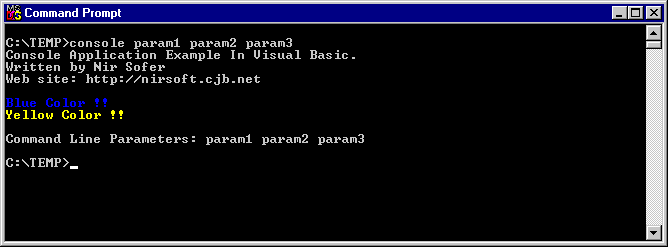|
|
Creating a real console application in Visual Basic
|
Some development tools, like Visual C++ and Delphi, allows the developer to easily create console applications. These tools provides specific methods and functions for writing to the console screen and their compiler also provides special option for creating console executable.
Unfortunately, Visual Basic doesn't support console applications. Even if you use the Win32 API for writing into the console screen,
Your application won't work, because the Visual Basic compiler always creates GUI application and it doesn't provide any compiler options for changing it to console application.
But... with a small trick, it's possible to bypass the limitation of the Visual Basic compiler:
I have developed a small utility that converts an Executable file (.exe) from GUI application mode to console application mode.
So, you can develop a console application in Visual Basic, create an executable file, and then, use my utility to convert the executable into a console application.
My utility was developed in Visual Basic, and the source code is provided within the sample package. You can use it by opening the appmodechange project from Visual Basic IDE.
In order to create a console application in Visual Basic, you have to use Win32 API calls.
The following code snippet writes a few lines into the console screen, some of them are shown in different colors !
Public Declare Function GetStdHandle Lib "kernel32" _
(ByVal nStdHandle As Long) As Long
Private Declare Function WriteFile Lib "kernel32" _
(ByVal hFile As Long, _
lpBuffer As Any, _
ByVal nNumberOfBytesToWrite As Long, _
lpNumberOfBytesWritten As Long, _
lpOverlapped As Any) As Long
Public Const STD_OUTPUT_HANDLE = -11&
Private Type COORD
x As Integer
y As Integer
End Type
Private Type SMALL_RECT
Left As Integer
Top As Integer
Right As Integer
Bottom As Integer
End Type
Private Type CONSOLE_SCREEN_BUFFER_INFO
dwSize As COORD
dwCursorPosition As COORD
wAttributes As Integer
srWindow As SMALL_RECT
dwMaximumWindowSize As COORD
End Type
Private Declare Function GetConsoleScreenBufferInfo Lib "kernel32" _
(ByVal hConsoleOutput As Long, _
lpConsoleScreenBufferInfo As CONSOLE_SCREEN_BUFFER_INFO) As Long
Private Declare Function SetConsoleTextAttribute Lib "kernel32" _
(ByVal hConsoleOutput As Long, ByVal wAttributes As Long) As Long
Private Const FOREGROUND_BLUE = &H1 ' text color contains blue.
Private Const FOREGROUND_GREEN = &H2 ' text color contains green.
Private Const FOREGROUND_INTENSITY = &H8 ' text color is intensified.
Private Const FOREGROUND_RED = &H4 ' text color contains red.
Private hOutput As Long
Private Function WriteToConsole(sText As String) As Boolean
Dim lWritten As Long
If WriteFile(hOutput, ByVal sText, Len(sText), lWritten, ByVal 0) = 0 Then
WriteToConsole = False
Else
WriteToConsole = True
End If
End Function
Public Sub Main()
Dim scrbuf As CONSOLE_SCREEN_BUFFER_INFO
hOutput = GetStdHandle(STD_OUTPUT_HANDLE)
GetConsoleScreenBufferInfo hOutput, scrbuf
WriteToConsole "Console Application Example In Visual Basic." & vbCrLf
WriteToConsole "Written by Nir Sofer" & vbCrLf
WriteToConsole "Web site: http://nirsoft.mirrorz.com" & vbCrLf & vbCrLf
SetConsoleTextAttribute hOutput, FOREGROUND_BLUE Or FOREGROUND_INTENSITY
WriteToConsole "Blue Color !!" & vbCrLf
SetConsoleTextAttribute hOutput, FOREGROUND_RED Or _
FOREGROUND_GREEN Or FOREGROUND_INTENSITY
WriteToConsole "Yellow Color !!" & vbCrLf
SetConsoleTextAttribute hOutput, scrbuf.wAttributes
If Len(Command$) <> 0 Then
WriteToConsole vbCrLf & "Command Line Parameters: " & Command$ & vbCrLf
End If
End Sub
|
After you create an executable file from this code, you have to use the Application Mode Changer for changing the executable mode from GUI application to console application.
After you convert it to console mode, you'll get the following result:

|
|

